Chemicals
| Infobox on Chemicals | |
|---|---|
| Example of Chemicals |  |
| Facts | |
| Origin | - |
| Stowage factor (in m3/t) | - |
| Humidity / moisture | - |
| Ventilation | - |
| Risk factors | - |
Chemicals
Contents
Description
Many chemicals have been dealt with in the different sections under their own names, including where appropriate the IMDG Code classification.
It will be appreciated that to include all or even satisfactorily deal with groups of chemicals to proper advantage would be a mammoth task. The readers are therefore recommended to acquire or have access to a good chemical dictionary, a copy of the Carriage of Dangerous Goods in Ships, commonly known as the ‘Blue Book’, issued by the Department of Transport, and a copy of the International Maritime Dangerous Goods (IMDG) Code, issued by the International Maritime Organisation.
Numerous chemical products are in use with names which provide no indication of potential danger, thus it is necessary to check primarily whether the chemical is (a) harmless, or (b) hazardous. This can very often only be determined by a chemist or through the owner or manufacturer of the product. Care should be taken to differentiate between the natural corrosion of containers of chemicals, with subsequent loss of contents, and loss due to old or second-hand containers. Some chemicals absorb moisture on exposure to the atmosphere, when the substance is said to be deliquescent, and the phenomenon is known as deliquescence. Efflorescence is the converse phenomenon, when a substance evolves moisture upon exposure to the atmosphere and is said to be efflorescent. These phenomena require to be taken into consideration when shortage or excess weight out-turns cannot otherwise be explained.
See: http://www.coleparmer.com/Chemical-Resistance
For an endless list of Chemical Products and relevant data we may refer to:
http://www.chemicalland21.com/listaz01.htm#T











